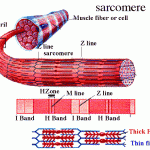In a review of 37 studies of men and women over 60, researchers found that a proper exercise program enlarged and strengthened the muscles in 93 percent of the participants (Osteoporosis International, March 1, 2017). In only 14 percent of the participants was there any additional benefit from nutritional changes.
In another study, researchers at the Mayo Clinic compared high-intensity aerobic interval training, resistance training and combined training in a group of 72 men and women, 65-80 years old (Cell Metabolism, Mar 10, 2017). All three training types reduced body fat, increased sensitivity to insulin to help control blood sugar levels and increased the amount of protein in muscles. However, they showed that only high-intensity aerobic training led to improvement in two of the most important markers of the aging processes: the maximum ability to take in and use oxygen (VO2max), and mitochondrial function in muscles.
How Intense Exercise Improves VO2max
With aging, you lose VO2max, your maximal ability to take in and use oxygen. Anything that increases V02max can increase your ability to move faster and helps to protect you against diseases associated with aging such as heart attacks. The only exercise that really increases VO2max is one that forces you to become short of breath and make you breathe harder and faster. Interval training is the most effective form of exercise that causes you to become short of breath, and it can be done with any activity that has continuous motion: running, cycling, swimming and so forth. You pick up the pace of your exercise until you develop signs of oxygen deprivation:
• starting to breathe harder and faster, and
• feeling a burning in your muscles.
Then you immediately slow down to catch up on your oxygen debt. When the muscle burning is completely gone and you can breathe at your normal rate, you can pick up the pace again. If you are not training for competition, you can limit each interval to 10-30 seconds, because during that time you will not build up significant amounts of lactic acid or cause much muscle damage, so you can do lots of repeat intervals. Competitive athletes can also use long intervals that take more than two minutes each, but they can do only a few of these repeats since they cause significant muscle damage.
Mitochondrial Function in Muscles
You have two major sources of energy in your cells:
• Glycolysis, the conversion of sugar to energy, and
• The Krebs Cycle, a series of chemical reactions that convert all foods to energy.
The Krebs cycle is found only in mitochondria, many small compartments inside all the cells in your body except mature red blood cells. Glycolysis is found in all cells and occurs outside the mitochondria. With aging, mitochondria lose some of their efficiency. Exercise has been shown to help preserve the form and function of mitochondria, and this new study confirms that intense exercise gives measurable improvement in mitochondrial function.

How Aging Causes Muscle Loss and Weakness
Every muscle is made up of many different fibers just as a rope is made of many different strands. Each muscle fiber is innervated by a single nerve. Everyone can expect to lose nerves with aging, and with loss of each nerve, you also lose the muscle fiber that it controls. For example, the vastus lateralis muscle in the front upper lateral side of the thigh has 800,000 fibers in a 20-year old, but only 250,000 fibers in a 60-year old. You can slow this loss of muscle strength by using exercise to increase the size and strength of the remaining muscle fibers. The key to enlarging each muscle fiber is to exercise it against enough resistance to cause minor muscle damage. When each muscle fiber heals, it becomes stronger. That is why all people should try to do some type of resistance training as they age.
Muscle Strength Parallels Bone Strength
Each exercise strengthens only the muscles and bones that are specifically stressed by that exercise. For example, running strengthens only leg bones and rowing strengthens only arms and back bones (Medicine & Science in Sports & Exercise, October 2005).
The greater the force an exercise places on bones, the greater the strengthening effect. Walking puts little stress on bones, so it does not strengthen bones effectively. Lifting heavy weights requires great force on bones, so it is one of the best bone strengthening exercises. Running downhill stresses and strengthens leg bones more than running on level ground because it places greater force on the leg bones (Appl Physiol Nutr Metab, Dec 2015;40(12):1309-12).
Weight-bearing endurance exercise and resistance exercise increase bone size and strength in older women and men, but aging decreases the bone strengthening effect of exercise, most likely because aging decreases muscle size and strength (Int J Sport Nutr Exerc Metab, Dec 2001;11:Suppl:S137-42).
My Recommendations
Since aging weakens both your bones and muscles and increases your risk for breaking bones, every person who can do so safely should try to exercise every day.
• Try to include both activities with continuous motion and exercises against resistance in your program.
• Continuous endurance exercise such as biking, running, and swimming strengthen primarily your heart and weightlifting stresses primarily your skeletal muscles.
• Just using and contracting your muscles in any activity offers health benefits, but you can gain additional benefits by adding intensity with some form of interval training.
• Take the day off if your muscles feel sore or fatigued after a 5-10 minute pre-workout warmup because that is when you are at increased risk for injuring yourself.
• Stop exercising immediately when you feel pain in a muscle or tendon because that is often the first sign of an impending wear-and-tear injury.
Caution: Intense exercise can cause heart attacks in people with blocked arteries. Always check with your doctor before starting a new exercise program or making a change in the intensity of your existing exercise program.
Checked 12/3/18

